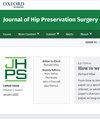Is core decompression and bone marrow concentrate with demineralized bone matrix and platelet-rich fibrin suitable for treating femoral head osteonecrosis?
IF 1.1
4区 医学
Q3 ORTHOPEDICS
引用次数: 0
Abstract
The aim of this article is to determine the safety and efficacy of core decompression (CD) combined with injection of autologous bone marrow concentrate (BMC), demineralized bone matrix (DBM), and platelet-rich fibrin (PRF) for treating femoral head osteonecrosis. Seventy-seven patients (53 males and 24 females) for a total of 87 hips were treated for hip osteonecrosis with CD combined with injection of autologous BMC, DBM, and PRF at Rizzoli Orthopedic Institute from September 2008 to December 2019. Patients were assessed at baseline, at 45 days, and at 3, 6, 12, 24, and 36 months postoperatively. The primary outcome was the survival rate of hips not converted to total hip arthroplasty (THA). The secondary outcomes were (I) radiographic positive evolution assessed by X-ray films and magnetic resonance imaging and (II) the clinical symptoms evaluated with the Harris Hip Score (HHS). Eighty-seven hips from 77 patients with femoral head osteonecrosis (FHON), 60 males and 27 females, with a median age of 34 years (range 15–55) were included. The cause of necrosis was steroid treatment in 30 patients (17 of these for hematological malignancies, 2 for lupus, 1 for Churg–Strauss syndrome, and the remaining for other causes), 1 was alcohol-related, 4 followed hip injury, while 15 patients had idiopathic causes. THA was carried out in 20 hips (40%). These patients had lesions classified as IIa on the Ficat stage in four cases, six were IIb, nine were III, and one was 4. No CD-related complications were found during THA surgery or at the last follow-up in these cohorts of patients. Radiographic progression of the FHON was found in 14 hips (28%), with a higher percentage on Ficat’s stage IIb. There were procedure-related complications in two hips, including one femoral neck fracture and one deep infection. Nineteen hips with successful treatment had good to excellent functional results at a 3-year follow-up or more (HHS ≥ 80). The long-term outcomes of treatment with CD and injection with BMC combined with DBM and PRF are promising to prevent femoral head collapse in patients with FHON. Moreover, CD does not influence the outcome in cases of THA.核心减压术和含有脱矿物质骨基质和富血小板纤维蛋白的骨髓浓缩物是否适合治疗股骨头坏死?
本文旨在确定核心减压(CD)联合注射自体骨髓浓缩物(BMC)、去矿物质骨基质(DBM)和富血小板纤维蛋白(PRF)治疗股骨头坏死的安全性和有效性。2008年9月至2019年12月,瑞佐利骨科研究所对77名患者(53名男性和24名女性)共87个髋关节进行了CD联合注射自体骨髓浓缩物、去矿物质骨基质和富血小板纤维蛋白治疗髋关节骨坏死的治疗。对患者进行了基线、45 天、术后 3、6、12、24 和 36 个月的评估。主要结果是未转为全髋关节置换术(THA)的髋关节存活率。次要结果是:(I) 通过X光片和磁共振成像评估的放射学阳性进展;(II) 通过哈里斯髋关节评分(HHS)评估的临床症状。77例股骨头坏死(FHON)患者的87个髋关节被纳入研究,其中男性60例,女性27例,中位年龄34岁(15-55岁)。30例患者的坏死原因为类固醇治疗(其中17例为血液恶性肿瘤,2例为狼疮,1例为丘格-斯特劳斯综合征,其余为其他原因),1例与酒精有关,4例为髋关节损伤,15例为特发性原因。20例(40%)髋关节接受了全髋关节置换术。在这些患者中,4 例患者的病变在 Ficat 分期中被归类为 IIa,6 例为 IIb,9 例为 III,1 例为 4。有14个髋关节(28%)的FHON出现放射学进展,其中Ficat分期为IIb的比例较高。有两个髋关节出现了手术相关并发症,包括一个股骨颈骨折和一个深部感染。19个治疗成功的髋关节在3年或更长时间的随访中获得了良好至卓越的功能效果(HHS≥80)。CD和注射BMC联合DBM和PRF治疗的长期疗效对预防FHON患者的股骨头塌陷很有帮助。此外,CD不会影响THA的疗效。
本文章由计算机程序翻译,如有差异,请以英文原文为准。
求助全文
约1分钟内获得全文
求助全文

 求助内容:
求助内容: 应助结果提醒方式:
应助结果提醒方式:


